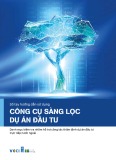
ISSN 1859-1531 - TẠP CHÍ KHOA HỌC VÀ CÔNG NGHỆ - ĐẠI HỌC ĐÀ NẴNG, VOL. 22, NO. 11A, 2024 65
CORPORATE INVESTMENT- FOREIGN OWNERSHIP RELATIONSHIP AND
THE ROLE OF LEVERAGE: THE CASE OF VIETNAM
MỐI QUAN HỆ GIỮA SỞ HỮU NƯỚC NGOÀI VÀ MỨC ĐỘ ĐẦU TƯ - VAI TRÒ CỦA
ĐÒN BẨY: NGHIÊN CỨU CHO VIỆT NAM
Thai Thi Hong An*
The University of Danang - University of Economics, Vietnam
*Corresponding author: antth@due.edu.vn
(Received: September 06, 2024; Revised: November 24, 2024; Accepted: November 25, 2024)
Abstract - This paper aims to investigate the relationship
between corporate investment and foreign ownership, taking into
account the indebtedness of firms. Using a sample of 669
Vietnamese quoted firms from 2010 to 2021, the System
Generalized Method of Moments (i.e., system-GMM) is
employed to investigate the relationship between investment and
foreign ownership. The paper finds that foreign shareholding
reduces corporate investment, and this influence is more
pronounced in highly leveraged firms. The outcome suggests that
in emerging markets like Vietnam, foreign investors focus on
short-term returns so that, long-term investment is cut back to
save resources for earnings pushing, leading to the so-called
“under-investment problem”. In the context of high debt levels,
besides ensuring short-term profitability, firms have to prioritize
debt repayment, making the tendency stronger.
Tóm tắt - Bài báo này nhằm mục đích khám phá mối quan hệ
giữa mức độ đầu tư của doanh nghiệp Việt Nam và sở hữu nước
ngoài, có tính đến yếu tố tác động của nợ vay. Sử dụng mẫu gồm
669 công ty niêm yết từ năm 2010 đến năm 2021, kết quả cho
thấy sở hữu nước ngoài có mối quan hệ ngược chiều với đầu tư
của doanh nghiệp và ảnh hưởng này rõ rệt hơn ở các công ty có
đòn bẩy tài chính cao. Điều này hàm ý rằng tại các thị trường
mới nổi như Việt Nam, các nhà đầu tư nước ngoài thường tập
trung vào lợi nhuận ngắn hạn, do đó, đầu tư dài hạn bị cắt giảm
để tiết kiệm nguồn lực dành cho các hoạt động thúc đẩy thu nhập
trong ngắn hạn, dẫn đến "vấn đề đầu tư dưới mức". Trong các
công ty có mức nợ cao, bên cạnh việc đảm bảo lợi nhuận ngắn
hạn, các công ty phải ưu tiên trả nợ, khiến hiện tượng này trở
nên mạnh hơn.
Key words - Financial constraints; foreign ownership;
investment; leverage; Vietnam
Từ khóa - Sở hữu nước ngoài; đầu tư; đòn bẩy; hạn chế tài chính;
Việt Nam
1. Introduction
Investment decisions aim to increase the value of firm
owners by deciding sufficient capital allocation to form
assets and investing in profitable projects. When firms invest
at a sufficient level, they can achieve sustainable growth.
According to M&M theory, investment decisions in the
perfect market should only be decided by the availability of
investment opportunities [1]. However, in the real world,
there is a variety of factors, including ownership, that might
affect corporate investment due to the existence of numerous
market frictions. Firms with high foreign ownership often
benefit from wider access to capital resources, advanced
management skills, broader networks, and high technology
brought by offshore investors [2]. In addition, by putting in
place strong corporate governance, foreign investors
contribute to the mitigation of agency problems and
information asymmetry within firms, which in turn
positively affect the effectiveness of decision-making [3].
Firms therefore are encouraged to take innovation and
productivity processes, resulting in higher long-term growth
and profitability (see [4]; [5]).
Although significant research effort has been made to
discover the effect of foreign ownership on financial
decisions, there are scant evidences of how ownership
influences investment, taking into account the situation of
external financing. Before us, [6] studied the impact of
foreign ownership on innovation investment in China and
found that the positive relationship between foreign
ownership and innovation investment only exists if firms
can access deeper domestic financial markets. This study
motivates us to investigate the role of indebtedness in the
relationship between offshore ownership and long-term
investment level.
Our paper focuses on Vietnam – an emerging market
currently drawing in foreign capital despite the fact that the
high information asymmetry, weak corporate governance,
and immature equity market continue to be problems. When
investing in this equity market, foreign investors typically
take on an active role in monitoring and controlling the
companies they invest in. In situations where a firm is highly
indebted, these foreign owners may intensify their oversight
to ensure that resources are allocated and aligned with
shareholder interests. This heightened monitoring can lead to
increased capital expenditures aimed at fostering future
growth and development. Conversely, if foreign investors
prioritize short-term returns, this can hinder long-term
investment. In highly leveraged firms, their focus can shift
toward immediate profitability and debt repayment, which
may result in reduced capital spending. Thus, while foreign
ownership can potentially enhance investment through
governance oversight, the need to manage debt can constrain
long-term growth initiatives, creating a complex dynamic
between foreign investment and corporate financing
strategies. In order to explore deeper into these arguments
and provide stakeholders with relevant policy implications,
we conduct a study on comprehensive data of 669

66 Thai Thi Hong An
Vietnamese quoted firms from 2010 to 2021. The outcome
indicates that there is a negative link between firm investment
and foreign ownership ratio; and in highly leveraged
enterprises, this relationship becomes more evident.
2. Literature review and hypothesis development
2.1. The relationship between foreign ownership and
firm investment
Researchers mainly depend on the theories of
information asymmetry and agency issues to explain how
ownership affects investment (see [7]; [8]). Agency theory
[9] states that managers might not always behave in the best
interests of shareholders, thus conflicts of interest may arise
between these two parties. Under the fear of possible losses
on their current positions or income or reputations, managers
may forgo profitable projects. According to the asymmetric
information hypothesis [10], managers and shareholders
may act differently depending on the amount of information
they have about projects. In many cases, managers have
more information compared to outside investors, including
foreign shareholders, thus they can make some misallocated
investment decisions and then reduce firm value.
When examining the role of foreign ownership, [4] uses
a sample of Spanish firms between 1990 and 2006 and finds
that foreign shareholding enhances firms to take on more
innovation-related projects. The authors argue that foreign
ownership brings not only financial resources but also
technological expertise and management practices, which
can enhance a firm's innovation capabilities and stimulate
investment in R&D. [3] explore a sample of firms in 64
countries and find that foreign investors significantly
increase investment. It suggests that foreign investors may
bring in additional capital and expertise, which can facilitate
firms' expansion and investment in productive assets. For the
Vietnam market, [11] documents that foreign ownership
increases the level of investment in fixed assets.
Other studies have provided empirical evidence
supporting the notion of a negative relationship between
foreign ownership and investment level. For example, [12]
finds that foreign ownership is associated with lower levels
of investment in Japanese manufacturing firms. They
explain that foreign investors are interested in projects that
promise positive equity returns. In other words, they tend
to prioritize short-term with highly expected gains over
long-term investment, leading to lower capital
expenditures. [13] also argue that the presence of foreign
investors seeking to maximize returns puts managers under
pressure to pursue short-term performance indicators, like
higher earnings-per-share or profit-after-tax of the current
term. Since short-term earnings’ reduction is interpreted as
a signal of potential performance problems; foreign owners
who focus on short-term earnings tend to sell stocks
following bad news. In that case, long-term investment is
forgone to save resources for earnings pushing, in order to
satisfy foreign investors’ requirements [14]. [15] examines
the Indian market and also finds that firms with high
foreign ownership tend to invest less.
Depending on these mixed evidences, the first
hypothesis is as follows:
H1a: There is a positive relationship between foreign
ownership and investment.
H1b: There is a negative relationship between foreign
ownership and investment.
2.2. The role of leverage
While considering the link between foreign ownership
and corporate investment, the indebtedness situation
should be taken into account [6]. Leverage, or the degree
to which a firm is financed by debt, can significantly
influence how foreign investors engage with a firm’s final
goals and its investment strategies.
On one side, off-shore owners often bring enhanced
monitoring and governance practices [3], which can
positively impact investment decisions, particularly in
firms with high levels of indebtedness. In such contexts,
these investors may implement stricter oversight to ensure
that resources are utilized effectively and aligned with
long-term growth objectives. Their involvement can
encourage firms to increase capital expenditures,
especially if foreign investors believe that strategic
investments will yield substantial returns in the future. This
could lead to a more proactive approach to corporate
innovation and development, driven by the need to enhance
competitiveness and profitability.
On the other hand, as mentioned earlier, if foreign
investors focus on seeking short-term returns, long-term
investment may be cut back to save resources for earnings
pushing [13]. This is particularly concerning for firms
facing significant financial obligations, as the necessity to
prioritize debt repayment can overshadow their investment
opportunities. In such cases, the foreign owners may
reallocate funds away from investment to meet debt
repayment commitments. Moreover, the influence of
leverage on foreign ownership-investment can be predicted
since foreign investors may view firms with high
indebtedness as riskier investments, leading them to go
away from funding long-term projects to avoid being tied
to those firms for extended periods.
In summary, leverage plays a considerable role in the
relationship between foreign ownership and firm investment
levels. Thus, we propose the second hypothesis as follows:
H2: The effect of foreign ownership on investment is
more pronounced in highly leveraged firms.
3. Methodology
3.1. Data
Our data is taken from the FiinPro database. We only
include non-financial firms listed on HOSE and HSX for
the period from 2010 to 2021. We exclude utility and
financial institutions since they have many differences in
operations and the way of listing financial information.
After winsorizing all variables 1% in each tail, a final
sample of 699 companies listed on the Vietnamese stock
market from 2010 to 2021 is used to run regressions.
3.2. Model
Following previous research on the same topic such as
[2], [6], [15], the model we use to examine the relationship
between investment and foreign ownership is as follows:

ISSN 1859-1531 - TẠP CHÍ KHOA HỌC VÀ CÔNG NGHỆ - ĐẠI HỌC ĐÀ NẴNG, VOL. 22, NO. 11A, 2024 67
INVi,t = β0+ β1INVi,t-1+ β2FOi,t-1 + β3LEVi,t-1+β4CFi,t-1
+β5SIZEi,t-1+ β6Qi,t-1 + ui,t (1)
The capital expenditure ratio is used to measure the
investment level of firm i in year t. The main explanatory
variable is foreign shareholding, which is measured by the
percentage of shares held by foreign investors. Leverage is
the total debt over the total assets. Other variables’
definitions and measurements are provided in Table 1.
Table 1. Variable descriptions
Variable
Definition
Measurement
CF
Cash flow
The sum of earnings before
extraordinary items and
depreciation/Total assets
SIZE
Firm size
Ln (Total assets)
Q
TobinQ
Market value of firms/ Book value of
firms
To clarify the role of leverage, the Eq. (1) is run for two
groups. These subsamples are classified based on the
industry median value of leverage, which is estimated by
industry and year. If a firm’s level of debt is higher than
the median value of the industry it belongs to, it goes to
high-leveraged groups, otherwise, it goes to the low-
leveraged category.
The lagged value of an investment is contained in
Equation (1); hence, it should be estimated by the system-
GMM technique [16]. By employing one-year-lagged
independent variables as instruments, this estimator
successfully handles potential endogeneity, such as
omitted variables and simultaneous causation between
investment and other determinants.
The statistics summary of all firm-level variables is
provided in Table 2. As shown, the capital expenditures
ratio of the observed firms is 14.2%, on average. The mean
leverage is 22% and the foreign investors hold around 8.8%
of total outstanding shares.
Table 2. Descriptive statistics
Obs
Mean
Std. Dev.
Min
Max
INV
6,127
0.142
0.043
0.000
0.276
FO
6,127
0.088
0.130
0.000
0.490
LEV
6,127
0.220
0.186
0.000
0.691
CF
6,127
0.085
0.098
-0.100
0.523
SIZE
6,127
27.266
1.593
23.679
31.585
Q
6,127
0.746
0.541
0.000
3.252
To provide an overview of the correlation between
variables, we perform a Pearson's correlation matrix. As
can be seen from Table 3, all pairwise correlation
coefficients between independent variables are below 0.8,
so the model has a low risk of multi-collinearity.
Table 3. The correlation matrix
INV
CF
SIZE
LEV
MTB
FO
INV
1.000
FO
0.013
1.000
LEV
-0.087
-0.086
1.000
CF
-0.038
0.201
-0.322
1.000
SIZE
0.080
0.265
0.373
-0.036
1.000
Q
-0.075
0.190
0.002
0.459
0.146
1.000
4. Result
First, the Eq. (1) is estimated using the method of two-
step system-GMM. Standard errors are shown in brackets
and the signals of *, **, *** are denoted to the significance
level at 0.1, 0.05, and 0.01, respectively. AR2 is second
order serial correlation check and Hansen test is for over-
identification restrictions.
Regression results for all firms and the non-COVID-19
period are presented in Table 4. The reason for conducting
tests for a non-crisis period is the undeniable impact of the
COVID-19 pandemic on the way firms make investment
decisions, as shown by [17]. Thus, to alleviate the concern
that COVID-19 can drive the regression results, besides the
full-sample test, we exclude the two years 2020-2021 and
re-run the Eq. (1). As shown in all columns of Table 4, the
coefficients of FO are negative and significant at 1% level,
suggesting that foreign investors discourage firms to take
more investment. This outcome supports our hypothesis
H1b. Interestingly, the coefficient of FO is higher for high-
leveraged firms, implying the effect of foreign ownership
is more evident when firms acquire a high level of debt.
This outcome supports our hypothesis H2. When re-
estimating the Eq. (1) for non-COVID-19 period, the
findings remain unchanged.
Table 4. Investment-foreign ownership relationship and
the role of leverage
Full sample
Non-COVID-19
High-
leveraged
Low-
leveraged
High-
leveraged
Low-
leveraged
L.INV
0.7399***
0.8111***
0.7149***
0.7675***
[0.0006]
[0.0016]
[0.0013]
[0.0042]
L.FO
-0.0047***
-0.0003***
-0.0041***
-0.0032***
[0.0006]
[0.0009]
[0.0011]
[0.0017]
L.LEV
-0.0141***
-0.0101***
-0.0146***
-0.0049**
[0.0007]
[0.0007]
[0.0014]
[0.0025]
L.CF
-0.0133***
-0.0163***
-0.0164***
-0.0117***
[0.0006]
[0.0003]
[0.0014]
[0.0014]
L.SIZE
0.0007***
0.0006***
0.0008***
0.0007***
[0.0001]
[0.0001]
[0.0001]
[0.0002]
L.Q
0.0024***
-0.0002***
0.0025***
-0.0006***
[0.0001]
[0.0000]
[0.0003]
[0.0002]
Const.
-0.0144***
-0.0116***
-0.0144***
-0.0138**
[0.0020]
[0.0019]
[0.0032]
[0.0056]
N
3081
3046
2459
2411
AR2
0.1766
0.1050
0.0759
0.1154
Hansen
0.2387
0.1889
0.2731
0.2107
In short, the results reveal that in Vietnam, foreign
shareholding reduces corporate investment, and this
influence is stronger in highly leveraged firms. The finding
is consistent with [12], [13], [15]. In emerging markets
which are characterised by uncertainty and information
asymmetry like Vietnam, foreign investors may focus on
seeking short-term returns on stocks rather than the long-
term development of firms they invest in. As a result,
capital expenditure is cut back to save resources for
earnings improvement, leading to a reduction in
investment level. In highly leveraged firms, this effect is
even more pronounced. The existing debt obligations

68 Thai Thi Hong An
create pressure to have immediate profitability, which can
deter foreign investors from supporting projects that
require substantial upfront capital but offer returns over a
longer horizon. These investors may fear that the high
levels of indebtedness could distort the firm’s financial
stability, leading them to prioritize immediate financial
performance over long-term growth.
Additionally, Vietnam with some uncertainties like
other emerging markets can even exacerbate this
reluctance. Foreign investors may have limited access to
reliable information about market conditions, competitive
dynamics, and regulatory environments, making long-term
commitments seem riskier. This means short-term gains
become more attractive as they allow investors to realize
returns quickly while minimizing exposure to potential
downturns.
Next, we re-run the Eq. (1) on two sub-samples with
different financial situations. Firms are classified into
more- and less likely to be financially constrained groups
since there are many differences in investment between the
two groups of firms [18]. We depend on the deficit value
calculated based on the guidance of [19] to separate firms
into the two groups (Deficit = (dividend + investments +
change in working capital - operating cash flow after
interest and taxes)/ Total assets; If a firm’s deficit value is
larger than 0, it is financially constrained; and vice versa).
As shown in Table 5, the regression results still reveal
the negative impact of foreign ownership on investment,
and the effect is stronger for highly leveraged firms.
Table 5. More- vs. less-financial constrained firms
More-constrained
Less-constrained
High-
leveraged
Low-
leveraged
High-
leveraged
Low-
leveraged
L.INV
0.7125***
0.7330***
0.3098***
0.4576***
[0.0009]
[0.0017]
[0.0020]
[0.0005]
L.FO
-0.0070***
-0.0031***
-0.0046***
-0.0016***
[0.0005]
[0.0005]
[0.0001]
[0.0003]
L.LEV
-0.0176***
-0.0168***
-0.0177***
0.0021***
[0.0004]
[0.0004]
[0.0002]
[0.0001]
L.CF
-0.0085***
-0.0222***
-0.0253***
-0.0015***
[0.0004]
[0.0007]
[0.0003]
[0.0002]
L.SIZE
0.0010***
0.0011***
0.0015***
0.0005***
[0.0001]
[0.0001]
[0.0001]
[0.0000]
L.Q
0.0030***
-0.0001**
-0.0013***
-0.0016***
[0.0001]
[0.0001]
[0.0000]
[0.0000]
Constant
-0.0190***
-0.0217***
-0.0305***
-0.0110***
[0.0028]
[0.0030]
[0.0030]
[0.0003]
N
2561
2412
520
634
AR2
0.2785
0.0802
0.6848
0.3987
Hansen
0.2632
0.1591
0.7605
0.0584
As an additional test, we take into account the firm
types since in Vietnam, the number of state-controlled
firms is still large, and state-owned enterprises (i.e., SOEs)
may have higher financial support from the government.
According to the 2020 Vietnamese enterprise law, firms
whose 50% or more shares are in the hands of the
government are SOEs, otherwise, they are non-SOEs.
Table 6 presents regression results for the two groups
of firms. Consistent with the previous tables, the negative
effect of foreign shareholding on corporate investment is
still found, and the discouragement influence of FO is
stronger for SOEs. Between the high and low-leveraged
firms of the two categories, the extent of the foreign
ownership’s effect is stronger for the high-leveraged firms.
Table 6. SOEs vs. non-SOEs
SOEs
non-SOEs
High-
leveraged
Low-
leveraged
High-
leveraged
Low-
leveraged
L.INV
0.7239***
0.9630***
0.7366***
0.7486***
[0.0002]
[0.0005]
[0.0005]
[0.0005]
L.FO
-0.0170***
-0.0054***
-0.0027***
-0.0008*
[0.0001]
[0.0002]
[0.0004]
[0.0004]
L.LEV
-0.0072***
-0.0020***
-0.0177***
-0.0158***
[0.0000]
[0.0001]
[0.0002]
[0.0005]
L.CF
-0.0112***
-0.0074***
-0.0159***
-0.0202***
[0.0004]
[0.0002]
[0.0002]
[0.0002]
L.SIZE
-0.0009***
0.0008***
0.0010***
0.0006***
[0.0000]
[0.0001]
[0.0000]
[0.0001]
L.Q
0.0014***
0.0004***
0.0027***
-0.0004***
[0.0001]
[0.0000]
[0.0001]
[0.0000]
Constant
0.0310***
-0.0187***
-0.0193***
-0.0088***
[0.0013]
[0.0014]
[0.0010]
[0.0020]
N
782
887
2299
2159
AR2
0.6555
0.7326
0.1001
0.1005
Hansen
0.6208
0.8767
0.0660
0.2051
Next, we take into account growth opportunities as the
investment activities indeed are different significantly
between firms with high- and low-growth opportunities
[20]. We follow previous studies to use Tobin’s Q to define
firm growth levels. That is, firms having the Tobin’s Q
larger than 1 belong to the high-growth opportunities group
and vice versa. As can be seen from Table 7, the negative
coefficients of foreign ownership are found in all columns.
Interestingly, in low-growth and low-leveraged firms, the
FO is insignificant related to firm investment.
Table 7. Firms with different growth opportunities
High growth
Low growth
High-
leveraged
Low-
leveraged
High-
leveraged
Low-
leveraged
L.INV
0.8659***
0.7414***
0.6521***
0.8306***
[0.0015]
[0.0006]
[0.0016]
[0.0010]
L.FO
-0.0034***
-0.0007**
-0.0072***
-0.0003
[0.0004]
[0.0003]
[0.0004]
[0.0007]
L.LEV
-0.0064***
-0.0205***
-0.0194***
-0.0076***
[0.0006]
[0.0006]
[0.0006]
[0.0008]
L.CF
-0.0083***
-0.0117***
-0.0150***
-0.0197***
[0.0007]
[0.0003]
[0.0004]
[0.0005]
L.SIZE
0.0001
0.0005***
0.0009***
0.0006***
[0.0001]
[0.0001]
[0.0001]
[0.0001]
L.Q
0.0019***
0.0003***
0.0043***
-0.0009***
[0.0002]
[0.0000]
[0.0001]
[0.0001]
Constant
0.0006
-0.0095***
-0.0169***
-0.0098**
[0.0018]
[0.0025]
[0.0021]
[0.0039]
N
503
709
2578
2337
AR2
0.3194
0.1815
0.0701
0.1115
Hansen
0.9944
0.4604
0.1399
0.0664

ISSN 1859-1531 - TẠP CHÍ KHOA HỌC VÀ CÔNG NGHỆ - ĐẠI HỌC ĐÀ NẴNG, VOL. 22, NO. 11A, 2024 69
5. Conclusion
Using the sample of 669 Vietnamese quoted firms from
2010 to 2021, we contribute to existing literature and
evidence that foreign ownership discourages firm
investment. The outcome suggests that in emerging
markets like Vietnam, foreign investors focus on seeking
short-term returns so that, long-term investment is cut back
to save resources for earnings pushing, leading to the
under-investment problem. In the context of high
indebtedness, besides ensuring short-term profitability,
firms have to prioritize debt repayment obligations, thus
foreign owners become more hesitant to make investment
decisions. Our finding holds strong across a variety of
robustness checks.
The findings suggest that while foreign ownership can
bring capital and expertise to Vietnamese firms, they tend
to have short-term focus, and market uncertainties create
unfavorable conditions that can limit corporate investment.
Addressing these challenges may require enhanced
transparency, improved governance practices, and
supportive policies that encourage long-term investment.
First, the Vietnamese government should propose suitable
regulatory policies in order to promote the long-term
involvement of foreign investors in domestic firms instead
of short-term trading. Besides, managers of firms, which
have large foreign shareholding, should carefully consider
the appropriate amount of investment, and avoid cutting off
profitable projects.
Although our study covers a large number of firms
listed on Ho Chi Minh and Ha Noi stock exchanges from
2010 to 2021, the results may not represent all Vietnamese
firms. Besides, it will be interesting to look deeper into
other types of ownership, like institutional or managerial
shareholdings. We leave these expansions for the future.
REFERENCES
[1] F. Modigliani and M. H. Miller, “The cost of capital, corporation
finance and the theory of investment”, American economic review,
vol. 48, no.3, pp. 261-297, 1958.
[2] Q. T. Phan, “Country-level governance quality, foreign ownership,
and firm investment: evidence from WBES database”, Cogent
Economics & Finance, vol. 12, no.1, e2302633, 2024.
[3] R. Chen, S. El Ghoul, O. Guedhami, and H. Wang, “Do state and
foreign ownership affect investment efficiency? Evidence from
privatizations”, Journal of Corporate Finance, vol. 42, pp. 408-421,
2017.
[4] M. Guadalupe, O. Kuzmina, and C. Thomas, “Innovation and
foreign ownership”, American Economic Review, vol. 102, no. 7, pp.
3594-3627, 2012.
[5] D. Greenaway, A. Guariglia, and Z. Yu, “The more the better?
Foreign ownership and corporate performance in China”, European
Journal of Finance, vol. 20, no. 7-9, pp. 681-702, 2014.
[6] S. Girma, Y. Gong, and H. Görg. “Foreign direct investment, access
to finance, and innovation activity in Chinese enterprises”, World
Bank Economic Review, vol. 22, no. 2, pp. 367-382, 2008.
[7] J. C. Stein, “Agency, information and corporate investment”,
Handbook of the Economics of Finance, vol. 1, pp. 111-165, 2003.
[8] C. J. Hadlock, “Ownership, liquidity, and investment”, Rand
Journal of Economics, vol. 29, no. 3, pp. 487-508, 1998.
[9] M.C. Jensen and W.H. Meckling, “Theory of the Firm: Managerial
Behavior, Agency Costs and Ownership Structure”, Journal of
Financial Economics, vol. 3, pp. 305-360, 1976.
[10] S. C. Myers and N. S. Majluf, “Corporate financing and investment
decisions when firms have information that investors do not have”,
Journal of Financial Economics, vol. 13, no. 2, pp. 187-221, 1984.
[11] Q. T. Tran, “Foreign ownership and investment efficiency: new
evidence from an emerging market”, International Journal of
Emerging Markets, vol. 15, no. 6, pp. 1185-1199, 2020.
[12] E. Gedajlovic, T. Yoshikawa, and M. Hashimoto, “Ownership
structure, investment behaviour and firm performance in Japanese
manufacturing industries”, Organization Studies, vol. 26, no. 1, pp.
7-35, 2005.
[13] P. David, T. Yoshikawa, M. D. Chari, and A. A. Rasheed, “Strategic
investments in Japanese corporations: Do foreign portfolio owners
foster underinvestment or appropriate investment?”, Strategic
Management Journal, vol. 27, no. 6, pp. 591-600, 2006.
[14] J. C. Stein, “Efficient capital markets, inefficient firms: A model of
myopic corporate behaviour”, Quarterly Journal of Economics, vol.
104, no. 4, pp. 655-669, 1989.
[15] A. Agarwal and N. Chaudhry, “Foreign controlling shareholders and
corporate investment”. Journal of International Financial Markets,
Institutions and Money, vol. 80, e101613, 2022.
[16] L. H. N. Ha and A. Thai, “Unexpected investment, tunnelling and
financial constraints”, International Journal of Emerging Markets,
vol. 18, no. 9, pp. 2152-2175, 2023.
[17] T. H. A.Thai, T. T. A. Vo, and M. Mazur, “COVID-19 and
investment–cash flow sensitivity: A cross-country analysis”,
Research in International Business and Finance, vol. 66, e102014,
2023.
[18] S. M. Fazzari, R. G. Hubbard, and B. C. Petersen, “Financing
Constraints and Corporate Investment”, Brookings Papers on
Economic Activity, vol. 1, pp. 141-195, 1988.
[19] M. Z. Frank and V. K. Goyal, “Testing the pecking order theory of
capital structure”, Journal of Financial Economics, vol. 67, no. 2,
pp. 217-248, 2003.
[20] K. H. Chung and K. H. Kim, “Growth opportunities and investment
decisions: A new perspective on the cost of capital”, Journal of
Business Finance & Accounting, vol. 24, no. 3, pp. 413-424, 1997.




![8 điểm cần biết về công ty cổ phần năm 2019 [chuẩn nhất]](https://cdn.tailieu.vn/images/document/thumbnail/2019/20190314/luatvietnamic/135x160/7191552549158.jpg)


![Pháp luật trong quản lý đầu tư và quản lý chất lượng công trình xây dựng [chuẩn nhất]](https://cdn.tailieu.vn/images/document/thumbnail/2013/20130829/henchidaubung/135x160/5971377750211.jpg)

![Đại lượng đo lường lãi suất trong đầu tư trái phiếu: [Thông tin chi tiết]](https://cdn.tailieu.vn/images/document/thumbnail/2013/20130625/yenhoangbank321/135x160/6751372135050.jpg)
















